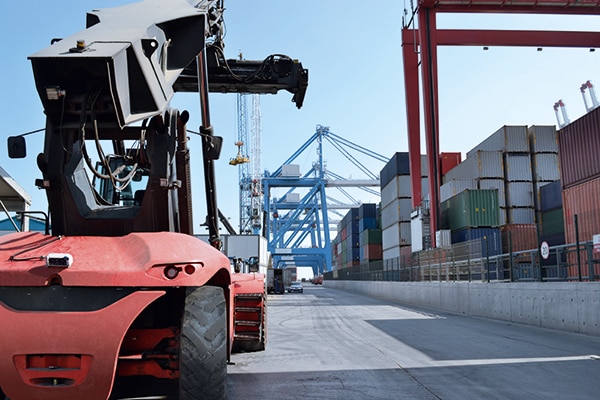No matter what the weather, you will find countless reach stackers in use at every port. The rugged Visionary-B CV 3D vision sensor with snapshot technology by SICK supports reach stacker operators with their frequent maneuvering and reversing operations. To help with this, the sensor detects relevant objects in the vehicles environment and generates live images that appear on the monitor. At the same time, the sensor uses visual and acoustic signals to warn the driver of possible collisions in critical driving situations. A plug and play solution, the Visionary-B CV is a breeze to configure and operate, and is ready for use in a matter of moments.
A reach stacker operator needs to deal with many different tasks. Although this includes driving the reach stacker, that is not the operators most critical task. Instead, the operator needs to be able to focus on container turnover. Whats more, unlike normal cars, reach stackers are not just used for brief periods, but they maneuver backwards for several hours at a time. This is precisely where the Visionary-B CV can help thanks to the use of 3D technology. The technology means that the operator does not need to constantly concentrate on the monitor as is the case for conventional passive camera systems. The Visionary-B CV lets the operator focus on the key tasks while still maintaining awareness of critical situations whenever they occur.
Snapshot technology using the two-eye principle
Monitor with live images of the vehicle environment.
The Visionary-B CV records objects around the vehicle with two images from slightly different perspectives. These two slightly different images are used to calculate information about the distance, which represents the third dimension. The principle of operation is similar to the way humans perceive space. Using this two-eye principle, the sensor head captures raw 3D data and transmits it to the evaluation unit which is programmed to analyze the vehicles environment and warn the operator only in the event of critical situations. The built-in data evaluation unit from SICK enables reliable detection of two classes of outdoor objects. Object class 1 detects larger vehicles and other relevant obstacles, such as electrical cabinets, within the monitoring zone. Object class 2 checks the vehicle width against the detection zone. This configuration is suitable for areas like narrow passages because it means that no unnecessary and distracting signals are emitted. The sensor works as a standalone solution and also includes an integrated recording function, which can be used for continous data recording.
Making the blind spot visible again
Several kits are available in version A, B, or C.
The typical reach stacker rear end is 2 m tall and 3 m wide. This size creates blind spots directly behind the vehicle that need to be made visible to the operator. Several kits are available in version A, B, or C. Kit A for the Visionary-B CV fulfills this task with utmost efficiency. The kit consists of a sensor head, an evaluation unit, a monitor, and corresponding mounting tools. Anyone looking to equip a wider vehicle or anyone who finds that the vehicles shape means that one sensor head is not enough can use kit C. Kit C is made up of two sensor heads and evaluation units, which apply a masterslave principle to emit the merged signal via a discrete output to one or, if necessary, two monitors. Kit B is used if you wish to make the areas both in front of and behind the vehicle visible. Kit B is made up of two sensor heads, an evaluation unit, a monitor, and a switch box that switches between the necessary sensor heads. Variable configurations are available for the detection zones so that the driver assistance system triggers a warning only in truly critical situations. Matching the vehicle width to the detection zone ensures there are not any superfluous signals, such as when driving through narrow passages.

Visionary-B CV kits from SICK are an indispensable aid in cases where a reach stacker operator is looking to concentrate more on his main job of turning over containers instead of just on driving.
- Product informationen: Visionary-B CV, Visionary-T
- Product portfolio: 3D Vision



